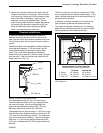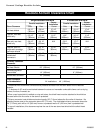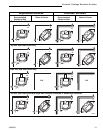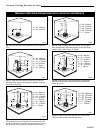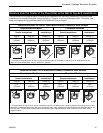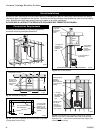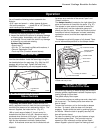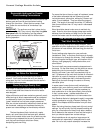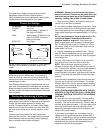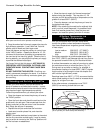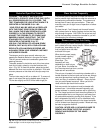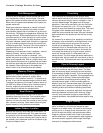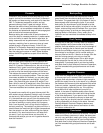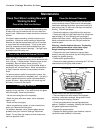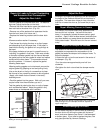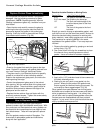
19
Vermont Castings Resolute Acclaim
2000893
firing rate of your heater by altering the air control
adjustment range outlined in these directions.
Use the following air control settings as a starting point
to determine the best settings for your needs.
Primary Air Settings
Air Setting Air Control Position
CLOSED Fully Left
LOW Approximately 1" (25mm) to
the right of CLOSED.
HIGH Approximately 3"(80mm) to the
right of CLOSED, where the
lever hits the stop.
START-UP Fully Right
WARNING: Operate only with doors fully open or
doors fully closed. If doors are left partly open, gas
and flame may be drawn out of the fireplace stove
opening, creating risks of both fire and smoke.
1. Open the stove damper, and open the primary air
control fully to the Start-up position.
2. Lay some crumpled newspapers in the stove. Place
six or eight pieces of dry kindling split to a finger-width
size on the paper, and on the kindling lay two or three
larger sticks of split dry wood approximately 1-2" (25-50
mm).
Do not use chemicals or fluids to start the fire. Do
not burn garbage or flammable fluids such as
gasoline, naptha or engine oil. Also, never use
gasoline-type lantern fuel, kerosene, charcoal lighter
fluid, or similar liquids to start or “freshen up” a fire in
this heater. Keep all such liquids well away from the
heater while it is in use.
3. Light the newspaper and close the door. The fire
soon will be well-established and you may gradually
build it up by adding a few sticks at a time of a progres-
sively larger size.
For your initial three or four break-in fires, let the fire
burn brightly for a short time, then let it die out.
NOTE: Some chimneys need to be “primed,” or
warmed up, before they will draw sufficiently to start a
fire. To correct this situation, roll up a couple pieces of
newspaper, place them on top of the kindling and
toward the back of the stove, light them, and close the
doors. This should get the smoke moving in the right
direction.
Once the draft is established, open the front door and
light the rest of the fuel from the bottom. Do not light
the main bed of fuel until the chimney begins drawing,
and repeat the procedure as often as necessary if the
initial attempt is unsuccessful.
NOTE: CONTINUOUS OPERATION WITH THE AIR
CONTROL IN THE START-UP (FULLY OPEN) POSI-
TION MAY SHORTEN THE LIFE OF THE INTERNAL
CASTINGS.
4. Once the fire is burning steadily, continue adding
fuel until a thick ember bed has been established on
the grate. The bed must be about 4" (100 mm) deep at
the back of the grate and about 1" (25 mm) deep at the
front, and should cover the throat opening into the
secondary combustion chamber that is located in the
center of the lower fireback.
If your wood is well-seasoned, the damper may be
closed when the griddle temperature reaches 500° F.
(260°C.). Depending on the type of wood being burned
and its moisture content, it may take several hours to
establish and then maintain the ember base that is
required for high-efficiency operation.
Low
High
Start-up
Normal
Operation
Move handle down and to
the right for start-up position
Fig. 29 Variable settings for the primary air control between
the open and closed positions provide a range of heat
output.
ST613
How to Build and Sustain a Wood Fire
You can load wood into your Resolute Acclaim through
either the top or front loading door. Front-loading is
useful for kindling a new fire, but we recommend top
loading as the most convenient way of regularly adding
several logs at a time.
Your Resolute Acclaim may be operated with the front
door open for fireplace-style viewing as well as closed.
Always be certain that the stove damper is open when
the door is open and always use the optional firescreen
for fire viewing.
Starting and Maintaining A Wood Fire
A new stove needs to be "broken in." Since cast iron
plates expand and contract in response to temperature
change, let them adjust gradually to heating and
cooling. To properly break in your stove, follow Steps 1-
3 below only for your first three or four fires. After that,
you may go on to Step 4 and normal operation of the
stove.
The stove paint and cement will emit a slight odor
during the first few fires. We suggest that you provide
extra ventilation near the stove by partially opening a
door or window when the odor is present.



